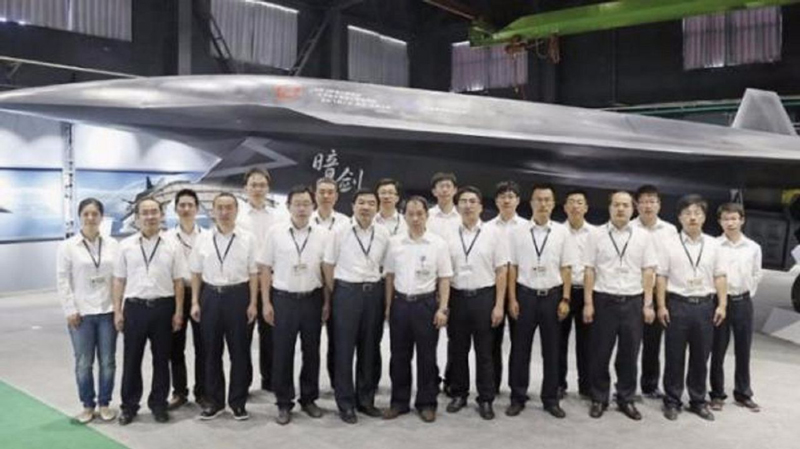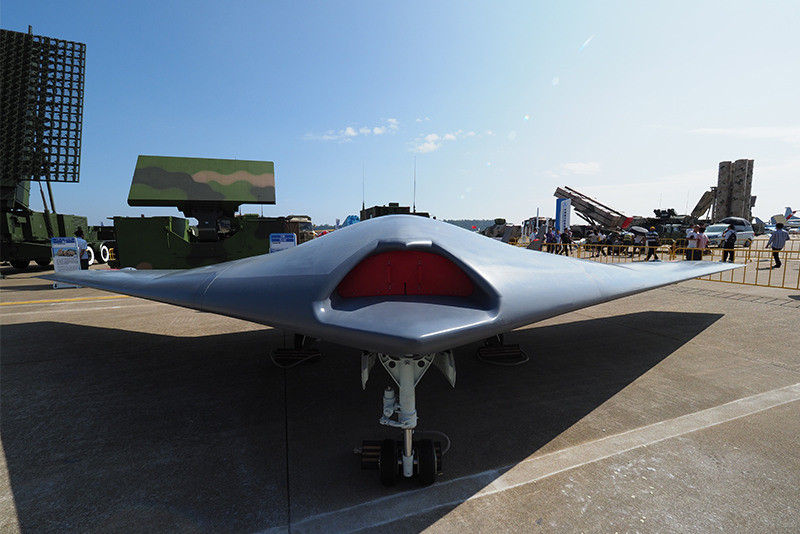By | Jr Ng | June 5, 2019
JR Ng – China has been steadily pushing ahead in its development of stealthy, unmanned deep penetration aircraft in recent years.
The People’s Republic of China (PRC) is beginning to reap the harvest of a decades-long investment into its unmanned aircraft research and development (R&D) sector, with a host of new and emerging unmanned combat air vehicles (UCAVs) being showcased in recent years.
Indeed, Chinese unmanned aircraft R&D capabilities have come a long way since the late 1950s, when the People’s Liberation Army (PLA) delegated the development of such systems to university aeronautical departments, which eventually spawned a vast industry that has gone from meeting domestic commercial and military requirements to serving a growing customer base overseas.
While these have often been overshadowed by other advanced military programmes and many of these UCAVs have yet to enter known service and will likely remain as paper designs or R&D testbeds, there is ample evidence that the technologies derived from these efforts will go on to inform even more sophisticated future designs as the PLA’s continued transformation drives further growth of advanced airborne capabilities over the coming decade.
Dark Sword and Sharp Sword
In June 2018, an image of a full-scale technology demonstrator of the secretive An Jian (Dark Sword) UCAV surfaced on Chinese news portals and social media. The undated photograph showed a large UCAV featuring an elongated, gunmetal-coloured airframe with canard surfaces and a ventral engine air intake that adopts a diverterless supersonic inlet (DSI) design. Saw-tooth edges can be seen on the air vehicle’s port side landing gear door.
The Dark Sword UCAV is believed to be a project of the state-owned Aviation Industry Corporation of China’s (AVIC’s) Shenyang Aircraft Design Institute (SYADI) – also known as the 601 Aircraft Design Institute – which aims at investigating technologies relevant for low-observable flying wing UAVs under the wider ‘AVIC 601-S’ programme.
Details of the air vehicle’s physical dimensions and capabilities remain undisclosed, but the air vehicle appears to be around 13-15 metres in length based on visual references.
Although the status of the Dark Sword programme remains largely shrouded in mystery with no images of the air vehicle seen in flight to date, the company’s other known low-observable UCAV development called the Li Jian (Sharp Sword) – which is manufactured by the Hongdu Aircraft Industries Corporation (HAIC) – has gained far more public exposure. It was first seen in May 2013 conducting taxiing trials at HAIC’s airfield in Nangchang, Jiangxi Province, and subsequently performed its maiden flight from the same facility.

Dark Sword (Credit: Chinese internet sources)
Chinese internet reports suggest that an improved Sharp Sword prototype commenced trials in 2016, indicating that the UCAV could enter service as early as 2020 should R&D work go smoothly. The project team was also awarded the country’s prestigious National Science and Technology Advancement Prize in 2017, which suggests that development is at a mature stage and the UCAV close to operational testing and evaluation with the PLA.

Sharp Sword (Credit: Chinese internet sources)
Meanwhile, Zhong Tian Guide Control Technology Company (ZT Guide), also a Xi’an-based private firm, has announced an ambitious programme to develop a large UCAV with a MTOW of 48,500lbs (22,000kg) called the Fei Long-2 (Flying Dragon-2) Multirole High-Subsonic Unmanned Transportation Platform, which adopts a flying-wing design and features a proposed 13,227lbs (6,000kg) internal payload capacity. The company aims to roll out a prototype by around 2021.
Official specifications state that the FL-2 will be a turbofan-powered air vehicle that can achieve cruise and maximum speeds of up to 324 knots (600 km/h) and 421kts (780 km/h) respectively, and can operate out a range of 4,350 miles (7,000km) and altitude of 49,000 feet (15,000m) .
ZT Guide is also investigating a supersonic UCAV concept called the FL-71 Supersonic Unmanned Transportation Platform, which is envisioned to be a 6,614lbs (3,000kg) class platform that can fly at maximum speeds of up to 1,188kts (2200km/h) for over an hour, with a total range of 560 miles (900km).
Rainbow 7
The state-owned China Aerospace Science and Technology Corporation (CASC) is developing a turbofan-powered high-altitude UCAV called the Cai Hong 7 (CH-7) that will have maximum take-off weight (MTOW) of 28,660lbs (13,000kg).
The company unveiled a full-scale mock up of the proposed CH-7 design at the Airshow China exhibition in Zhuhai, Guangdong Province, in November 2018. The prototype CH-7 on was the centrepiece display in the company’s hall and adopts a flying wing airframe with a 10m length and 22m wingspan and dorsally mounted low-observability engine intake and exhaust. Other features include serrated edges for the undercarriage and payload bay covers to preserve the air vehicle’s low-observability characteristics.

Cai Hong 7 (Credit: JR Ng)
It will be also able to carry a range of precision-guided weapons including anti-radiation, anti-ship, air-to-ground missiles, and bombs, as well as electronic warfare payloads including active and passive sensors, and jamming systems.
CASC is reportedly aiming to perform the first flight of the CH-7 prototype by the end of 2019, with design work on the production-ready model expected to be finalised by 2022. Although the air vehicle is presently designed to be a land-based aircraft, company officials confirmed that it could be further developed into a naval aircraft and operate from an aircraft carrier.
Star Shadow
Star UAV System, a private company specialising in UAV technologies has unveiled its twin turbofan-powered Star Shadow UCAV concept in early 2018. The Star Shadow is is expected to have a MTOW of 8,818lbs (4,000kg) when fully constructed.
Official specifications indicate that the truncated diamond-shaped air vehicle will have an overall length of 7.3m with sweptback outer wings that have a total span of 15m. Star UAV claims that its design offers radar cross section (RCS) performance in the range of 0.1m² for greatly improved survivability at standoff ranges, where it is designed to operate for most of its flight envelope.
Further design themes also include control surfaces that are built into the trailing edges and upper sections of the fuselage and wings. A pair of low observable engine intakes are located on either side of the nose leading to similarly configured exhaust outlets towards the rear of the fuselage.
The Star Shadow will also be equipped with a ventral payload bay measuring 2.5m long and 0.76m wide that can accommodate up to 882lbs (400kg) of mission equipment or weapons.
Chengdu Chinese Academy of Sciences Aircraft Engine Company will supply two indigenously developed TWS800 turbofan engines, which is expected to provide cruising speeds between 216-324kts (400-600km/h) and a maximum speed of nearly 378kts (700km/h) while operating at altitudes of nearly 40,000ft (12,000m). The air vehicle will also carry to 3,306lbs (1,500kg) of fuel that will support up to 12 hours of endurance depending on the mission profile.
Star UAV is reportedly readying the Star Shadow for its maiden flight around mid-2019, although the company has since taken the concept out of public view, suggesting that it has either ceased development work or under strict non-disclosure obligations to a state-linked launch customer.
Tian Ying
State-owned China Aerospace Science and Industry Corporation (CASIC), the country’s leading manufacturer of missile systems, is also developing the ‘fully autonomous’ Tian Ying (Sky Hawk) technology demonstrator. The company unveiled the prototype to the public for the first time in late 2018 since it announced a successful series of trials earlier in the year
An internally funded development, the Tian Ying has a MTOW of 6,614lbs (3,000kg) and adopts a low-observable flying wing design comparable to Lockheed Martin’s RQ-170 Sentinel reconnaissance UAV. The Tian Ying is believed to have conducted at least three successful test flights during the four years after development commenced.

Tian Ying (Credit: JR Ng)
CASIC did not disclose detailed information about the Tian Ying, but it appears that the air vehicle could be aimed at aircraft carrier operations considering its relatively compact wingspan of approximately 11m and a particularly robust undercarriage
“The Sky Hawk UAV is used to perform strategic and tactical close-in reconnaissance of important targets in high-threat combat environments,” the company stated. “It is capable of long-endurance flight, and autonomous wheeled take-offs and landings."
“[It] features high stealth, long endurance, full autonomy, low cost and large combat radius,” the company added.
XY-280 stealth target drone
Besides reconnaissance and strike missions, stealth-optimised UAVs are also being developed for other types of missions including target training. For example, private firm Xi’an Lontek Technology Company is offering the XY-280 Stealth UAV as a high-speed target that is designed to hone the skills of radar and air-defence artillery forces in countering low-observable threats.

XY-280 (Credit: JR Ng)
“The XY-280 is designed to present the rough targeting characteristics of western fifth-generation aircraft such as the F-22 and F-35,” a company spokesperson said, noting that the drone can operate autonomously.






 ...
...